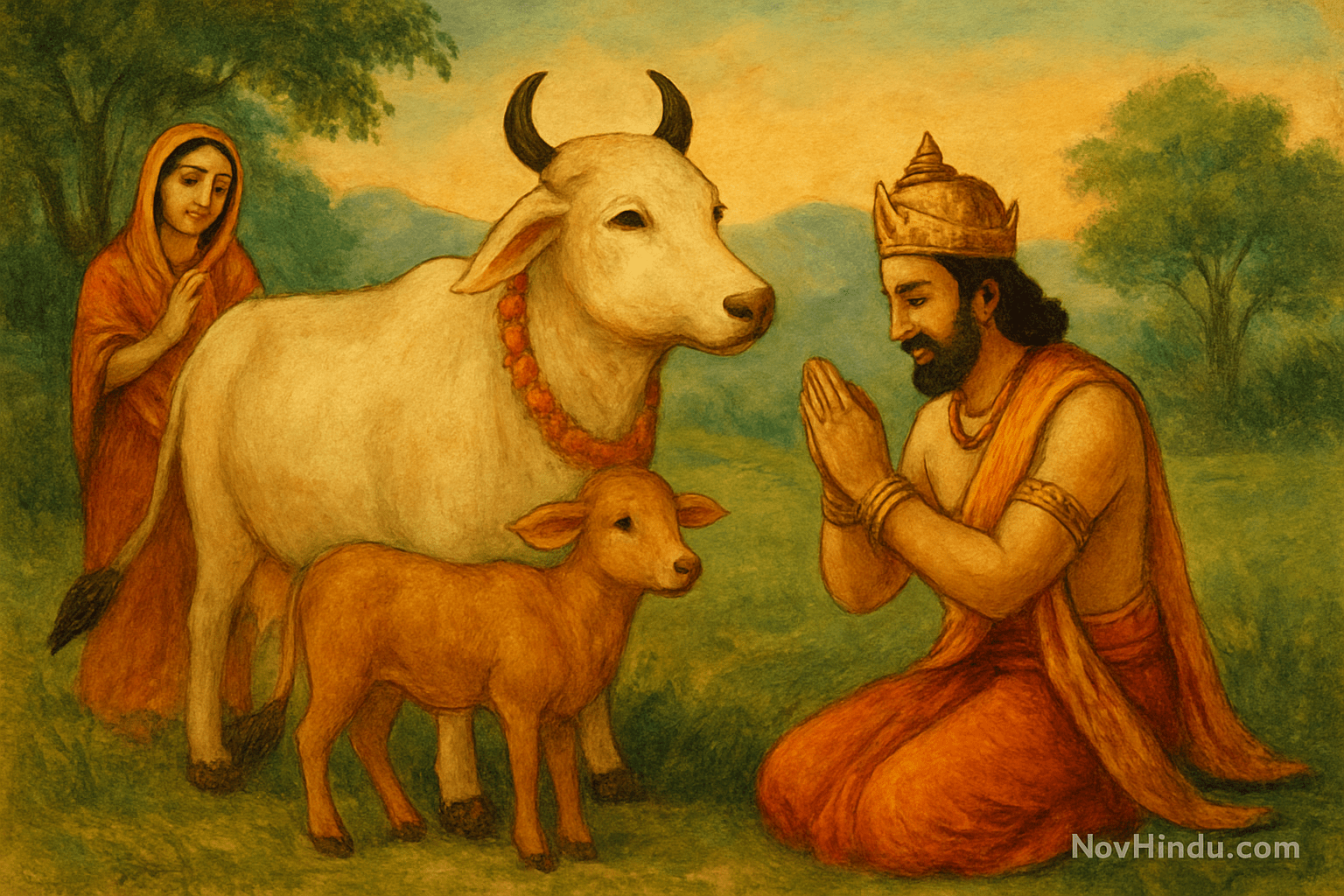Among the many kings whose stories echo through the sacred halls of Hindu epics and Puranas, Chakravarthi Raja Dilīpa stands out—not for war, not for conquest, but for a simple, pure-hearted act of cow devotion (Gau Bhakti) that defined what it means to live Dharma.
This is the story of a king who ruled not only with power, but with reverence—for the divine, for nature, and for the sacred bond between humanity and Gau Mata.
The Noble Lineage of Raja Dilīpa
Raja Dilīpa belonged to the Ikshvaku dynasty—the same royal line that gave birth to Lord Rama, Harishchandra, and other great torchbearers of righteousness. He was the father of Raghu, whose name lives on in the title Raghukul (the lineage of Raghu), and the progenitor of what would become the Raghuvamsha.
But despite being the supreme ruler of the earth, one aspect of his life remained incomplete. He and his queen, Sudakshina, had no children—an ache that bore heavily on their hearts.
The Unseen Offense Against Kamadhenu
In their quest for a child, Dilīpa and Sudakshina sought guidance from their kulguru, Sage Vasishta. The sage, after deep meditation, revealed a forgotten karmic thread:
“O King, during your heavenly journey, you once walked past Kamadhenu, the divine cow, and offered her no pranam, no salutation. Though you meant no harm, your indifference has been taken as disrespect.”
Kamadhenu, the wish-fulfilling cow and mother of all bovine beings, lived in heaven, while her daughter Nandini resided in Vasishta’s ashram on Earth.
To earn forgiveness and the blessings of progeny, the king was advised to serve Nandini with absolute devotion.
The Royal Couple in the Ashram
And so began a royal tale of humility. The mighty monarch and his queen left behind the luxuries of the palace and arrived at the sage’s humble forest ashram, dressed in simple robes.
For twenty-one days, they served Nandini as sevaks, not rulers. Dilīpa accompanied her to the forest every day, protecting her from danger, feeding her, watching her graze—much like a loyal guard, even as the sun beat down and wild beasts roamed nearby.
But the true test was yet to come.
The Lion in the Forest – A Test of Dharma
One afternoon, as Nandini grazed peacefully, a fierce lion emerged from the shadows and roared:
“This cow belongs to Lord Shiva. She has entered my forest. I will take her as food.”
Dilīpa was stunned but stood firm. He offered his own body in exchange, saying:
“Take me, O lion. Spare this sacred cow. She is under my protection. My life is yours.”
As the lion prepared to attack, Dilīpa folded his hands in surrender. But nothing happened.
Suddenly, the illusion vanished—the lion, the danger, the threat. All gone. It was a divine test, created by Nandini herself, to measure the king’s sincerity.
The Blessing of a Child
Moved by his purity and selflessness, Nandini blessed the king and queen. When they returned to their kingdom, the queen conceived, and in time gave birth to Raghu, a son of immense virtue and strength, whose legacy would shape the future of Sanatan Dharma.
The story of Raja Dilīpa teaches that the highest form of bhakti is action rooted in humility and service, not just rituals.
The Symbolism of the Story
Every element of this katha holds layered meaning:
- Kamadhenu and Nandini are symbols of Mother Nature, nourishment, and divine grace.
- The lion represents our inner ego and pride, always ready to overpower our dharma.
- Dilīpa’s surrender shows the pinnacle of Kshatriya Dharma—to protect the helpless, even at the cost of one’s life.
- The forest is not just a location, but the wild unpredictability of life where Dharma is constantly tested.
Gau Seva as a Spiritual Ideal
This katha is not merely historical—it continues to inspire Hindu ethics today, especially in the reverence for cows, seen not merely as animals, but as givers of abundance, patience, and stability.
Raja Dilīpa’s devotion gave spiritual legitimacy to Gau Seva as a sacred duty. Even Lord Krishna, much later, would embody this ideal through his life as a cowherd in Vrindavan.
Why This Story Still Matters
In an age where convenience trumps devotion, and reverence for nature is eroding, this story reminds us of our responsibilities—toward Dharma, toward the Earth, and toward beings that nourish us silently.
True Bhakti is not grand temples or dramatic rituals. It is service. It is humility. It is sacrifice.
Just like Raja Dilīpa, whose quiet service echoed across generations and shaped a lineage of kings that lived by the sword but ruled by Dharma.
